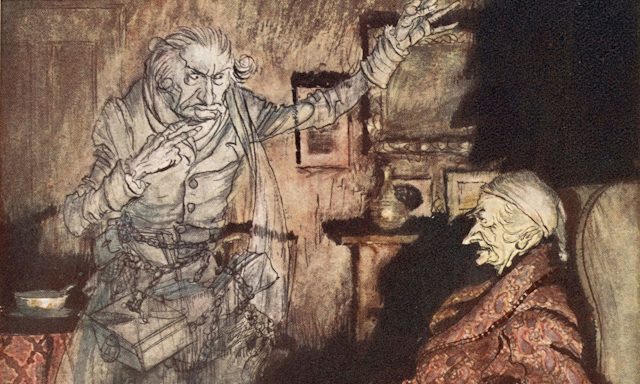With a joyful celebration of family love and communal bonds at its heart, Charles Dickens’s story A Christmas Carol has often been credited with creating our modern idea of Christmas. Published on December 19 1843, the first edition sold out rapidly and the story was immediately adapted onto the Victorian stage.
The Internet Movie Database now lists 213 versions of the story, with the first film made in 1901, the same year Queen Victoria died. Less well-known than the story itself though is Dickens’s importance to our understanding of trauma.
In simple terms, trauma is a “wounding” event or situation that produces ongoing psychological symptoms, such as nightmares, flashbacks and distress. We take the idea of trauma for granted now.
It is an ever-present way of understanding and describing ourselves and the complex societies we live in. But at the same time, awareness of the impact of traumatic events such as war, displacement and adversity feels like an urgent necessity in our troubled world.
The psychological category of trauma is relatively new. The word was not used in English to describe a damaging psychological event until 1894. But the idea did not appear from nowhere.
As literary scholar Jill Matus has shown, the “newly forming discipline” of psychology theorised the concept of “shock” in the mid-Victorian period, exploring how the mind could be wounded and the body disorientated. Victorian doctors including Benjamin Ward Richardson identified new forms of “disease” arising from the fast pace of modern life, such as stress and fatigue.
Meanwhile, as I research in my own work, mid-Victorian writers traced and retraced how past events could impact the present. By focusing on painful childhood experiences, writers like Dickens and Charlotte Brontë (in the likes of Jane Eyre) helped shape the version of trauma we understand now.
The psychoanalyst Sigmund Freud argued that trauma could not be understood as a single event; it is defined by an unconscious “compulsion to repeat”, the trauma replayed in new scenes.
For Dickens, it is not just that bad stuff happens – it recurs, it haunts and this implicates who you are and who you can be. In A Christmas Carol, Dickens anticipates Freud’s work and psychoanalysis, which are equally concerned with the reverberating echoes of childhood.
Scrooge, neglect and forgetfulness
Scrooge is now a byword for meanness. In A Christmas Carol, Dickens crafts an allegory of trauma and recovery through Ebeneezer Scrooge’s moral redemption. In the first chapter, we witness him bullying Bob Cratchit, his long-suffering clerk, and reject his almost painfully cheerful nephew, Fred. We soon learn that Scrooge’s only friend was Jacob Marley, his business partner, now long since dead.
For Scrooge, all forms of human feeling are “humbug”. The remedies for collective suffering are the workhouse and the prison. The poor are better off dead. Our familiarity with Scrooge perhaps dulls the shock we should feel at these beliefs. Dickens is clear that Scrooge has broken ties with himself, other people and society – and the situation is not just unpleasant, it is dangerous.
Entwined in chains and cash boxes, Marley’s spirit visits Scrooge, warning that he too will be condemned to “wander through the earth” in an “incessant torture of remorse” if he doesn’t change his ways. Marley prepares Scrooge for the imminent arrival of three spirits: the ghosts of Christmas Past, Present and Yet to Come who offer him this chance of redemption.
The first of the three spirits takes Scrooge back to a Christmas scene from his childhood. There, he witnesses himself as a boy, alone in a cold, “melancholy” schoolroom which is “earthy” like a tomb.
We realise that Scrooge is not just a nasty old man, he is also a neglected child. He has unknowingly recreated his childhood loneliness in later life, confined to his miserable counting house. He sought comfort from money. With devastating consequences.
Mourning and recovery
Meanwhile, the young Scrooge cheers his solitary Christmas by reading The Arabian Nights and Robinson Crusoe, books loved by Dickens as a child. The characters spring from the pages. Imagination protects the boy and restores the adult, who is learning to remember. Scrooge must watch, listen to and feel every detail of this scene, which has a “softening influence”, giving “freer passage to his tears”.
Observing his younger self, Scrooge begins to accept the past and mourn his losses. Writing 50 years before Freud and Josef Breuer published their “preliminary communication” in psychoanalysis, in this eerie ghost story, Dickens presents a therapeutic scene.
But this is bigger than Scrooge. When he later meets the Ghost of Christmas Present, Scrooge must also acknowledge and grieve for the Victorian realities of poverty, adversity and cruelty – represented by the two allegorical children, Want and Ignorance.
As philosopher Judith Butler argued in her book Precarious Life, mourning can be an act of solidarity. In A Christmas Carol, Dickens shows us that it is also an ethical process. A fitting message perhaps for the 21st century, and for the harsh Christmas many have ahead of them during this cost of living crisis.

Looking for something good? Cut through the noise with a carefully curated selection of the latest releases, live events and exhibitions, straight to your inbox every fortnight, on Fridays. Sign up here.

